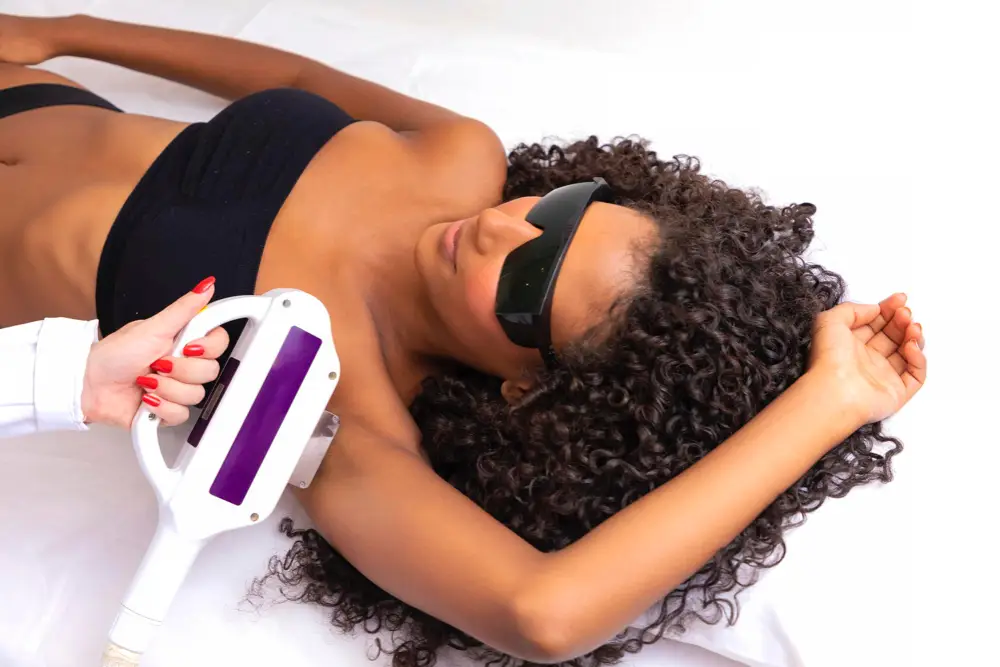If you’re not happy with shaving, tweezing, or waxing to remove unwanted hair, laser hair removal may be an option worth considering.
What is it?
Overview
Laser hair removal is a medical procedure that uses a concentrated beam of light (laser) to remove unwanted hair.
During laser hair removal, a laser emits a light that is absorbed by the pigment (melanin) in the hair. The light energy is converted to heat, which damages the tube-shaped sacs within the skin (hair follicles) that produce hairs. This damage inhibits or delays future hair growth.
Although laser hair removal effectively delays hair growth for long periods, it usually doesn’t result in permanent hair removal. Multiple laser hair removal treatments are needed for initial hair removal, and maintenance treatments might be needed as well. Laser hair removal is most effective for people who have light skin and dark hair, but it can be successfully used on all skin types.
Laser hair removal is one of the most commonly done cosmetic procedures in the U.S. It beams highly concentrated light into hair follicles. Pigment in the follicles absorb the light. That destroys the hair.
Lasers are useful for removing unwanted hair from the face, leg, chin, back, arm, underarm, bikini line, and other areas.
Benefits of Laser Hair Removal
Benefits of laser hair removal include:
- Long-term: Once the hair follicles have been destroyed, they will not grow back. This means that you can say goodbye to unwanted hair for good and get lasting results.
- Speed. Each pulse of the laser takes a fraction of a second and can treat many hairs at the same time. The laser can treat an area approximately the size of a quarter every second. Small areas such as the upper lip can be treated in less than a minute, and large areas, such as the back or legs, may take up to an hour.
- No more ingrown hair: Laser hair removal treatments eliminate ingrown hairs, minimizing the risk of inflammation, bumps, and itching.
- Safety. Thanks to new advances in laser hair removal technology, people with dark skin tones now enjoy the same level of safety as those with lighter complexions.
- Precision. Lasers can selectively target dark, coarse hairs while leaving the surrounding skin undamaged.
How to Prepare for Laser Hair Removal
If you are planning on undergoing laser hair removal, you should limit plucking, waxing, and electrolysis for six weeks before treatment. That’s because the laser targets the hairs’ roots, which are temporarily removed by waxing or plucking.
You should also avoid sun exposure for six weeks before and after treatment. Sun exposure makes laser hair removal less effective and makes complications after treatment more likely.
What to Expect During Laser Hair Removal
Just before the procedure, your hair that will be undergoing treatment will be trimmed to a few millimeters above the skin surface. Usually topical numbing medicine is applied 20- 30 minutes before the laser procedure, to help with the sting of the laser pulses. The laser equipment will be adjusted according to the color, thickness, and location of your hair being treated as well as your skin color.
Depending on the laser or light source used, you and the technician will need to wear appropriate eye protection.
It will also be necessary to protect the outer layers of your skin with a cold gel or special cooling device. This will help the laser light penetrate the skin.
Next, the technician will give a pulse of light to the treatment area and watch the area for several minutes to make sure the best settings were used and to check for bad reactions.When the procedure is completed, you may be given ice packs, anti-inflammatory creams or lotions, or cold water to ease any discomfort.
You may schedule your next treatment four to six weeks later.
You’ll get treatments until hair stops growing.
Recovery and Risks
For a day or two afterward, the treated area of your skin will look and feel like it’s sunburned.
- Cool compresses and moisturizers may help. If your face was treated, you can wear makeup the next day unless your skin is blistering.
- Over the next month, your treated hair will fall out. Wear sunscreen for the following month to help prevent temporary changes in the color of the treated skin.
Blisters are rare but are more likely in people with darker complexions. Other potential side effects are swelling, redness, and scarring. Permanent scarring or changes in skin color are rare.
Costs of Laser Hair Removal
The cost varies widely, depending on factors that include:
- Size of the area being treated and time required for treatment
- Number of treatments required
- Whether a doctor or someone else is performing the procedure
- The part of the country where you are having the procedure
Ask for a consultation with our team here to get a better idea of the cost for your particular case.


